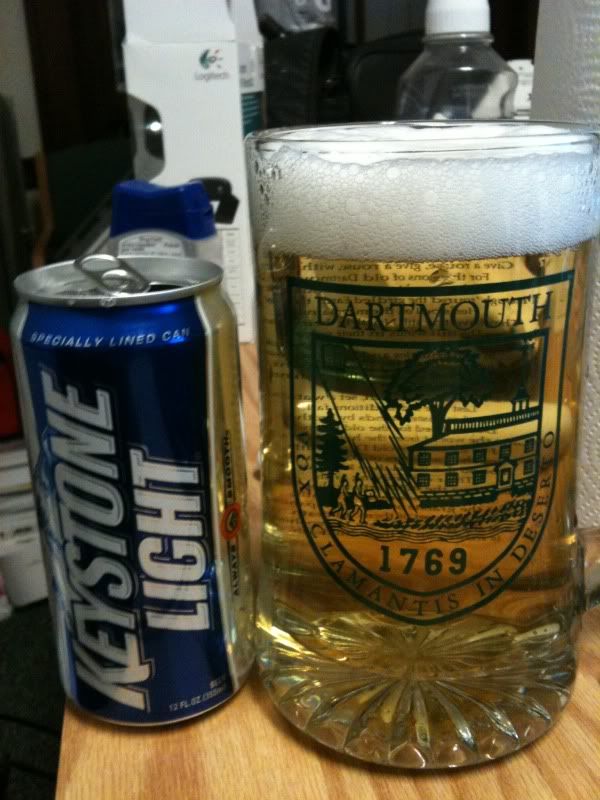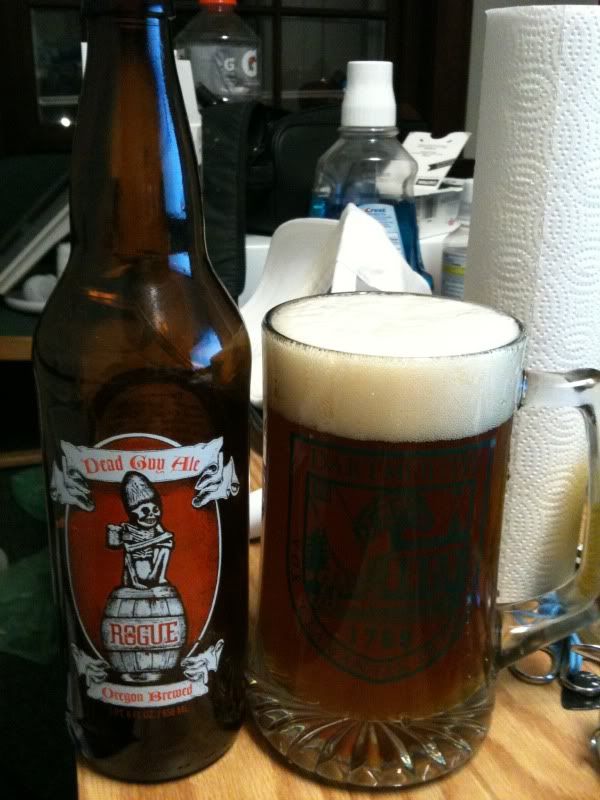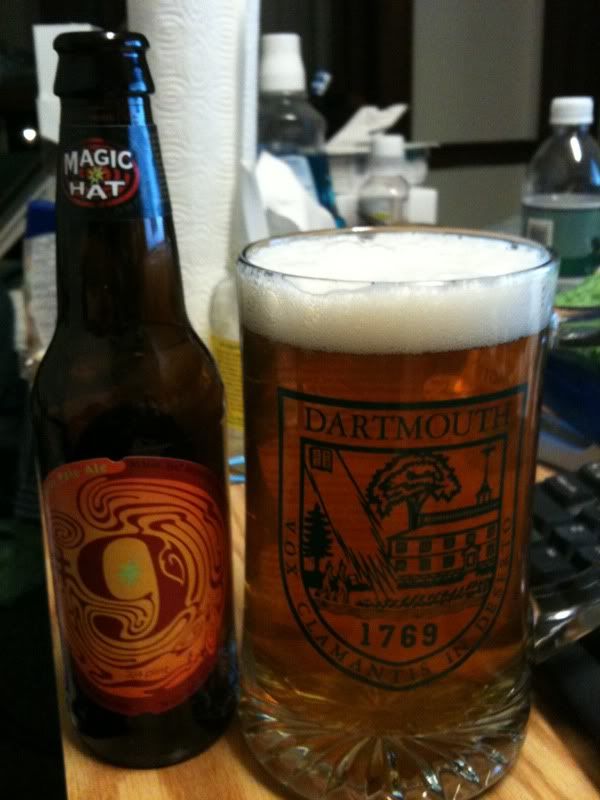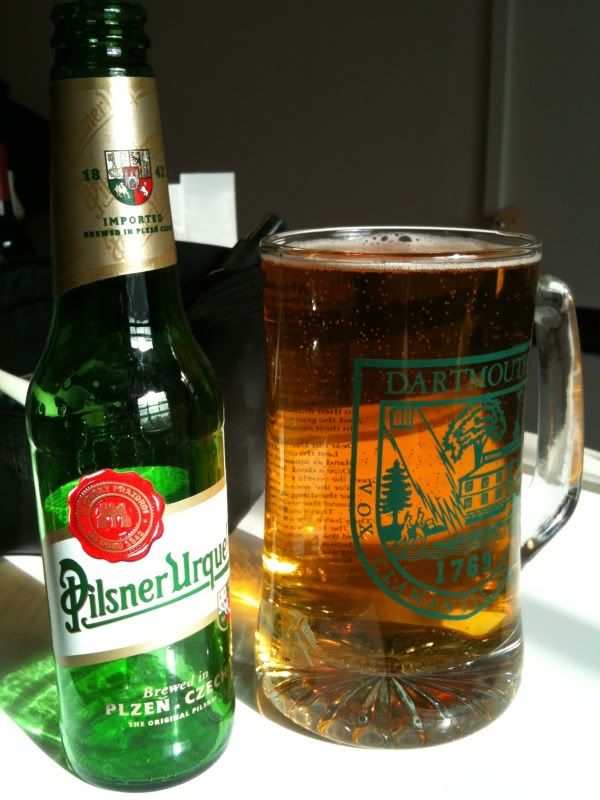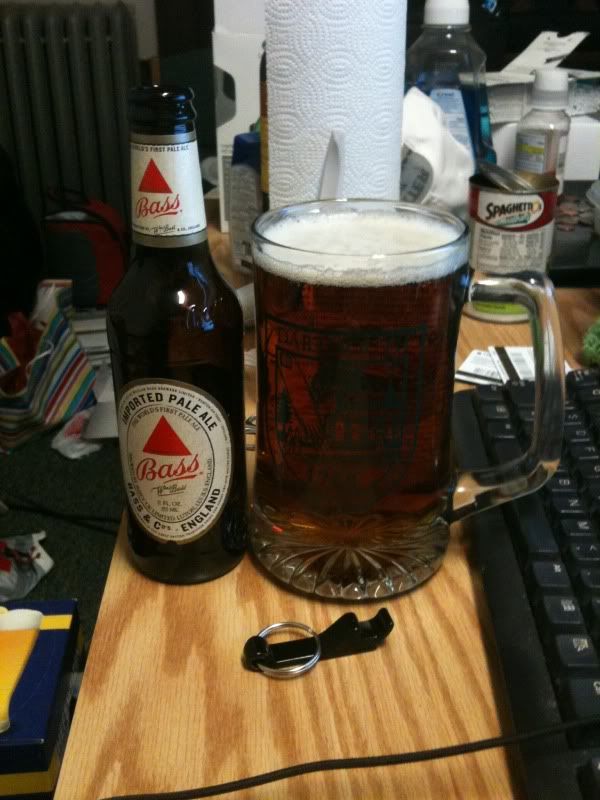Monday, January 31, 2011
Keystone Light
First Brewed: 1989
Brewery Location: Golden, Colorado, United States
ABV: 4.2%
History & Availability: Both Keystone and Keystone Light were introduced in 1989 by Coors, for reasons unknown to me (seeing as Coors Light had already existed for over a decade at that point). You can find 30s of Keystone Light pretty much anywhere in the US, but finding Keystone itself is a little bit harder, similar to how you can always find Coors Light but Coors is a mystical beast only rarely seen. Go figure. I hear in Canada they sell Keystone Light in bottles. Again, go figure.
Appearance: An extremely light-colored beer, it is also amazingly clear. Leaves a huge head (partially because it's canned, partially because of the carbonation) but that dissipates stunningly quickly. Carbonation is apparent but certainly not enough to sustain a head.
Smell: Ah, the familiar aroma of Keystone. Smells like a frat basement. Metallic, but more towards the tinny side of metallic than the coppery side. Hint of apple. Really a strong scent, I'm not quite sure why they went in this direction given that it's not a particularly good one.
Taste: Tastes like the can it came in. No subtlety here. Fortunately once you swallow it down, it leaves little aftertaste besides a lingering feel of carbonation, so you can chug it without necessarily having to taste it.
Mouthfeel: Plenty of carbonation. Medium weight for a light beer, which of course makes it much lighter than any average ale.
Drinkability: Fairly chuggable because it doesn't leave much taste behind, unlike some of the other more aggressive macrobrews. It's a little too carbonated to really allow mass drinking though, and it will tend to fill you up after 5 or so.
Overall verdict: D, one of the least offensive light beers, but you'd be better off leaving this one to the college students.
Sunday, January 30, 2011
Rogue Dead Guy Ale
First Brewed: 1988
Brewery Location: Newport, Oregon, United States
ABV: 6.4%
History & Availability: Founded in 1988, Rogue Ales have won dozens of awards in international beer competitions for their brewing prowess. Dead Guy is their most popular ale, in the Maibock style, a helles lager that is brewed to be as strong as a bock (a German strong, dark lager heavy on malt flavor) with less of a malt dominance and more room to play with the flavor of hops and others. Rogue exports to all fifty states and to a number of countries in the Americas and Europe, so if you search a few local importers you may have luck in finding this one.
Appearance: Pours slowly and leaves a large amber-tinted head. The beer itself is a deep mahogany color and very opaque; I can't even call it hazy because it's well beyond that. Not much carbonation is apparent, probably because it's so cloudy. All in all this beer looks delicious. Definitely the best-looking of the beers I've rated so far (although that's not really saying much).
Smell: Dead Guy has a really nice, multifaceted aroma. First and foremost is the scent of fresh-cut maple, which evokes a whole range of responses in me relating to nature, and probably appeals to me personally because I grew up in Maine where spending time in the forest isn't a vacation but rather daily life - although if you've ever spent time out in the woods this will be evocative nevertheless. Hidden beneath that delicious smell are undertones of hops, a little bit of citrus, and a hint of a sweeter additive like honey or molasses.
Taste: Such a rich taste, there are again a number of distinct angles that come to the surface as you let it wash around your tongue. I can pick out from among them a slight woody taste at the front, but it is light enough to not be overpowering; instead of the other tastes being masked behind it they are almost brought through it to dance around the mouth. There is an infusion of what feels like molasses filtering through - not strong enough to be syrupy which is definitely for the better, and a noticeable hoppy bitterness counteracts this well. The aftertaste is dry and bitter which leaves you craving another sip.
Mouthfeel: Smooth, Oh My God is this beer smooth. Dead Guy is on the heavier end of the weight scale if you consider it objectively, but it feels like it's floating around your mouth. There is just barely enough carbonation to properly circulate the flavors while still keeping the smooth character of the beer intact.
Drinkability: Although Dead Guy is, again, on the heavier end of the spectrum, this is much more drinkable than an average stout or quad due to its multifaceted taste, which keeps you more focused on the changing flavor than, say, Magic Hat #9 which was overloaded with a single flavor. Dead Guy generally comes in a 22oz bottle, which should be plenty for most drinkers.
Overall verdict: A, one of the best beers I've tasted.
Saturday, January 29, 2011
Magic Hat #9
First Brewed: 1994
Brewery Location: South Burlington, Vermont, United States
ABV: 5.1%
History & Availability: Magic Hat is the 8th largest craft brewery in America, with the apricot-infused #9 as its most popular beer. One of the more popular brands on the east coast, I've found Magic Hat to be available pretty much everywhere throughout New England, but given that it's a craft beer you may have trouble finding it if you live outside of the northeast.
Appearance: A surprisingly light ale, tending towards a bright amber. I've generally only had this beer out of the bottle before, and I was surprised by the color as I poured, although given the taste it definitely makes sense. #9 is also noticeably cloudy. Leaves a medium head, although once poured there is only moderate carbonation.
Smell: Very fruity. There is a distinct floral scent, but the beer still retains the prominent bitterness of the hops. Definitely a light scent, which furthers the overall goal of the beer to fall on the lighter end of the ale spectrum.
Taste: A floral or fruity taste immediately comes to the forefront as you sip this beer. Sweetness is definitely the most prominent characteristic here, although there is a decent undertone of a hoppy, bitter taste as well, that lurks below the surface until the beer hits the sides of your tongue, where it really comes out. The aftertaste is sweet and definitely has a floral feel to it.
Mouthfeel: Medium carbonation - just the right amount to agitate the flavors and bring them to all the right corners of the mouth, while still remaining subtle enough to not make holding a sip uncomfortable. Very light for an ale, there is very little weight beyond what you'd expect from a similarly sized sip of water. Feels a little heavier than a pilsner though, as expected. Any residue left behind dissipates almost immediately.
Drinkability: Due to the light color, light smell, and light flavor, #9 is very drinkable for the first 12 ounces. However, around the time you're halfway through your second bottle, there's a noticeable feeling of sweetness overload. You definitely wouldn't want to have more than two of these in a row, not because they're especially filling - which they aren't - but simply because it's a little bit too strong of a taste to handle over several bottles. This will be great if you're out at a restaurant and are only going to have one, worse if you're watching a game or something and want to have a few more.
Overall verdict: B+, a good beer to try if you're just starting out switching over from macrobrews.
Friday, January 28, 2011
Pilsner Urquell
First Brewed: 1842
Brewery Location: Pilsen, Bohemia, Czech Republic
ABV: 4.4%
History & Availability: As should be apparent from the name of the city in which the beer is brewed, the genre of beer known as "pilsners" originated from this very brewery in the city of Pilsen. Pilsner Urquell is no stranger to this fact either, branding themselves as "The Original Pilsner." In addition, Pilsner Urquell also happens to be the first-ever lager beer, meaning that it is brewed using bottom-fermenting yeast in a colder environment than was previously common. The most entertaining part of the history of Urquell is how it was originally conceived - around 1840 the government in Bohemia decided their beers were not up to snuff, literally dumped dozens of casks of ale on the street, hired a brewmaster from Bavaria as a consultant, and told the brewers to try something new. And so they did, and the lager beer was born, which gave rise to such popular favorites as Budweiser, Coors, Corona, Heineken, and many more. Pilsner Urquell is brewed with soft water, meaning water that has had its naturally-appearing solutes (such as calcium and magnesium) reduced, which as a side-effect increases the water's tendency to contain more metallic elements like copper. Because of Pilsner Urquell's prominence as the origin of all pilsners, it is distributed worldwide, and chances are it will be easy to find at any local distributor.
Appearance: A very light shade of amber, perhaps a bit darker than many pilsners but much lighter than most ales. The beer pours very cleanly, leaving essentially no head. Carbonation is fairly prominent but this may also be due to the fact that it is a very clear beer.
Smell: Little to none. I am jamming my nose right into this mug and all I'm getting is a little hint of a metallic scent. This is a little disappointing for me, as a good beer (like a good wine) should stimulate both senses to create a fuller experience. Now, granted, I certainly don't have the right glassware for a pilsner, which may have something to do with it - but then again maybe not.
Taste: Similar to the smell, there is not much taste to be found here. There's definitely that hint of a metallic taste cropping up again, but besides that it's almost watery in its lack of distinction. There's essentially no aftertaste at all besides a lingering feeling like you've consumed a piece of iron.
Mouthfeel: Very carbonated. It's uncomfortable to hold in your mouth for more than a few seconds, which made picking out a specific taste even harder. Like all pilsners, this is one of the lighter beers you'll find, so big sips will not overwhelm you with weight. Leaves behind a thin film which dissipates easily with a flick of the tongue.
Drinkability: It tastes like water. Water is very drinkable. Therefore, this pilsner is very drinkable. With the fairly low alcohol content, you can feel free to have two or three in situations where you might only have a single stout. Sadly given the overall unremarkability of the beer, you may not want too many of them.
Overall verdict: C; a truly unremarkable pilsner.
Wednesday, January 26, 2011
Bass Pale Ale
Brewery Location: Burton-upon-Trent, Staffordshire, England
ABV: 5%
History & Availability: Billed as "the world's first pale ale," a style that now spans the entire globe, Bass has had a strong impact on the world of beer and by most accounts has been relatively stable since its introduction in the 1700s. Bass was so popular through the 1800s, in fact, that it became the recipient of the UK's first registered trademark, as other brands tried to use Bass's distinctive red triangle mark to their advantage. In the US, Bass has become the most popular imported English beer (though not the most popular beer from the British Isles; more on that later). Since this beer is imported from England and is widely available around the globe, your chances of finding it in your local supermarket are fairly high.
Appearance: The ale has a medium color to it, as most pale ales do (despite the name) - somewhat coppery and with a very small and fast-dissipating head (this is the foam that appears when you pour the beer, for those of you who don't know the terms). It pours very easily and has what I'd call scant carbonation - not too little, but definitely not as much as you'd find in a fizzier beer or soda. Very clear; you could almost read through it given some backlighting. The picture I took is oddly dark and not really representative of the beer itself; I'll work on proper lighting for the next review.
Smell: The smell is sweet and very malty, nearly drowning out the other scents the ale has to offer. Upon closer inspection you can smell some woodiness to it but again the strong malt smell is really what to pay attention to here.
Taste: A very interesting taste for a pale ale. There's a hint of fruity flavor to this beer that you generally wouldn't find in an Indian or Belgian pale ale. The aftertaste especially leaves a hint of almost citrus-y flavor, or perhaps apricot. The infused taste is very strong in this ale, so if you're after something a little more "traditional" you might want to steer somewhere else; but if you're looking for an interesting fusion of pale ale with the dryer fruits, this is definitely something to try.
Mouthfeel: Medium weight; certainly more than most macrobrews but definitely not as much as a stout. The carbonation essentially disappears once sipped and except for a slight tingling at the tongue, there's not much activity in the mouth.
Drinkability: This is where the pale ale shines. Bass leaves little aftertaste after about 30 seconds, allowing you to continue to drink to your heart's content. A very smooth ale in my opinion. You can easily get through 3 or 4 of these in an hour or two and not feel weighed down at all. If you're looking for a drink that you can slosh around with your buds, this may be near the top of your chain.
Overall verdict: B, although be aware that the dry-fruity taste may not be for you.
Subscribe to:
Comments (Atom)
